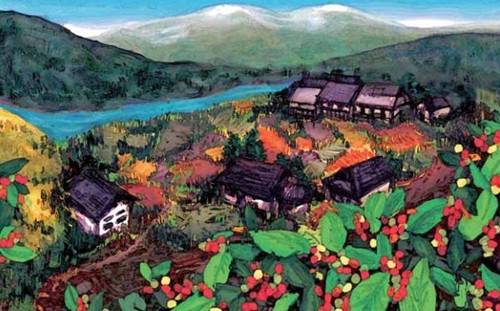Indonesian Bali Coffee Flavor characteristics Bali Fine Coffee beans
Indonesia Bali Karana Kintamani Ubud Natural
Country: Indonesia
Producing area: Kintamani Volcano area
Altitude: 1400 m
Harvest season: June to September every year
Treatment: insolation
Varieties: USDA, Karka, Smuri 795
Treatment plant: Wubu treatment plant
Flavor: ripe peach, pineapple, black sugar

In the traditional culture of Bali, coffee is used as a cheap beverage raw material. The flavor and quality of the region have been unstable or depressed, and most of them have become cheap commercial beans. Rodney and his partners decided to change the local people's stereotype of coffee. They chose Wubu Market, the cultural center of Bali, and opened the only boutique cafe on the island. Rodney and two other partners themselves have also obtained the international general coffee Q certification to check the quality of their own coffee, and it is also the only local cafe with this certification. The cafe has two bean dryers from 1kg and 4kg, and all the coffee in the shop comes from high-quality raw beans from the local or nearby producing areas (for example, Java, Sulawesi, New Guinea, Florus) and so on.
The success of the cafe has given them more motivation to pursue high-quality coffee sources. a few years ago, local coffee beans in Bali were processed by farmers in the Kintamani mountainous areas. however, regardless of weather factors, berry quality, post-production environment and other factors, it is always difficult for them to master the quality of raw beans in the past year.
Since 2015, Rodney has decided to build its own processing plant next to its vestibule and cafe. When the harvest season came last year, they went to the Jintamani area at an altitude of 1400 meters to buy high-quality coffee berries, and then carried them to the stable Wubu district of Tianhou 800m for post-processing.
This year, Rodney successfully experimented with three different batches, including water washing, honey treatment, sun treatment, and three different methods. The flavor greatly exceeds the general batches of origin, and the overall defect rate and uniformity are even better than those of fine beans in Central America. Water washing and honey treatment have bright and complex acidity, and the sun treatment batches are much better than those of Panama Manor. There are more ripe peaches, pineapples, mangoes and other tropical fruits, fruit wine aromas and finish.
The concept of Karana has received a great response in Bali, but apart from coffee itself and commercial achievements, they also recognize the problems of local life, education, industry, culture, and so on, so in the process of selling coffee, they also return its profits to the children's educational institutions in the local village to contribute to the education of future children, such as building schools or purchasing educational equipment.
Flavor description: raw beans exude strong cantaloupe and tropical fruit aromas; the entrance flavor changes to the sweetness of pineapple and strawberry jam, showing smooth and rich acidity at medium and low temperatures, with aromas of handmade black sugar, exquisite dark chocolate and hazelnut; the overall flavor is excellent, like syrup-like texture and sweet taste, the ripe fruit flavor of the sun even surpasses many well-known Central American estates.
Important Notice :
前街咖啡 FrontStreet Coffee has moved to new addredd:
FrontStreet Coffee Address: 315,Donghua East Road,GuangZhou
Tel:020 38364473
- Prev

Introduction of Coffee Origin-- the uniqueness of South African Fine Coffee the taste of South African coffee
It is fragrant with less acidity, reminiscent of coffee beans from Central America. Coffee production in South Africa (South Africa) is mainly in the northeast of the country, from Natal between Transvaal and Mozambique, extending northward to Transvaal, with the southernmost limit of latitude 30 south; further south, coffee cannot be grown due to the harm of early frost.
- Next

Tanzania boutique coffee introduces the characteristics of Tanzania boutique coffee Tanzania boutique coffee
Due to political instability and rampant diseases and insect pests, the coffee industry in Tanzania has been damaged, leading to a decline in the overall level of coffee and instability in quality, which in turn lead to lower prices, which are usually the result of a further decline in the coffee industry. What's more, it is estimated that more than 12% of the Arabica coffee grown in northern Tanzania from 1969 to 1985 was smuggled.
Related
- Does Rose Summer choose Blue, Green or Red? Detailed explanation of Rose Summer Coffee plots and Classification in Panamanian Jade Manor
- What is the difference between the origin, producing area, processing plant, cooperative and manor of coffee beans?
- How fine does the espresso powder fit? how to grind the espresso?
- Sca coffee roasting degree color card coffee roasting degree 8 roasting color values what do you mean?
- The practice of lattes: how to make lattes at home
- Introduction to Indonesian Fine Coffee beans-- Java Coffee producing area of Indonesian Arabica Coffee
- How much will the flavor of light and medium roasted rose summer be expressed? What baking level is rose summer suitable for?
- Introduction to the characteristics of washing, sun-drying or wet-planing coffee commonly used in Mantenin, Indonesia
- Price characteristics of Arabica Coffee Bean Starbucks introduction to Manning Coffee Bean Taste producing area Variety Manor
- What is the authentic Yega flavor? What are the flavor characteristics of the really excellent Yejasuffi coffee beans?

